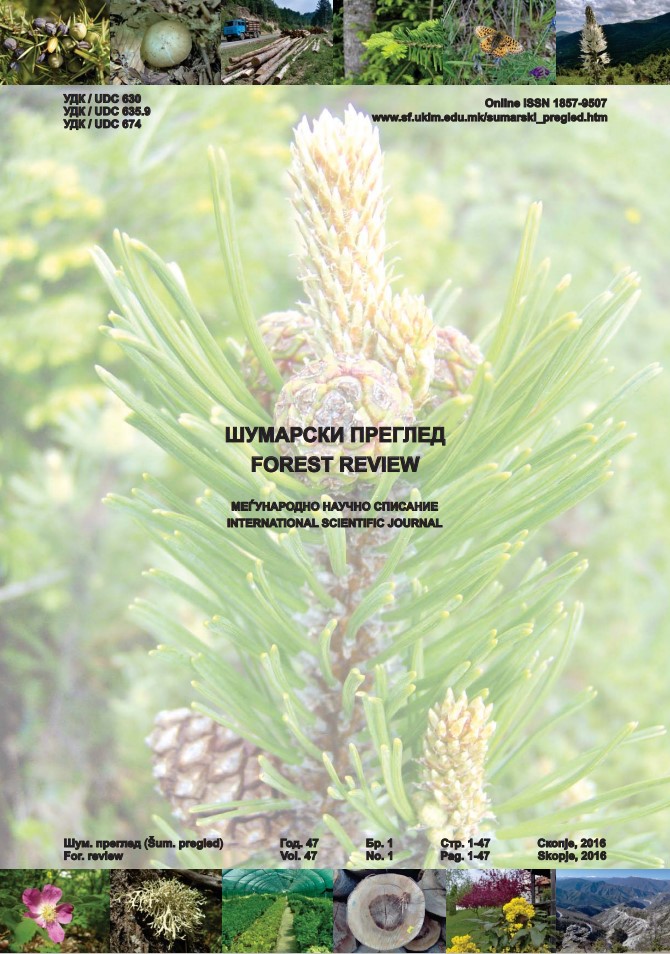Шумарски преглед, год. 47, бр. 1
Forest Review, Vol. 47, No. 1
Issue Articles
Number and quality structure of natural beech regeneration in round apertures on Bistra mountain
Authors: Milorad Andrijeski, Nikolco Velkovski, Kole Vasilevski, Boris Najdovski
⇑ DOI:
Original scientific article
Abstract:
This research is made on the number and quality structure of the natural regeneration of beech in round apertures on Bistra Mountain. It’s conducted by direct scientific research activities, by gathering information from the field. This information was later classified and processed by mathematical-static methods, and appropriate analysis were made, which results are shown both tabular and graphically. The study was made in pure beech forests represented in the Bistra Mountain. The natural conditions of the researched area, as essential for the growth and the survival of the forest ecosystems, also take a place in this paper. It was found that they are favorable for the development of forest vegetation. This paper also provides an overview of forest management in the past, as well as an analysis of results of taken silvicultural and regeneration measures, and it was determined that the studied forests have been under anthropogenic and zoogenic impact deep in the past. The development and the regeneration processes in the studied forests stands were being researched in their early development stages. The research was made under natural regeneration in round apertures and including quality structure of the offspring, as an important indicator over the next regeneration processes. From the conducted research is concluded that the beech forests of Bistra Mountain have a strong regeneration potential which is mainly correlated with the size of the round apertures.
Keywords: beеch, beеch forests, natural regeneration
Forest vegetation maps and its development in Turkey: a case from Istanbul-Belgrade forest
Authors: Süleyman Çoban, Selim Bayraktar, Mustafa Akgül
⇑ DOI:
Original scientific article
Abstract:
Forests provide a wide range of direct or indirect benefits to urban life which vary over space and time. Increasing demands from forest resources made planned forest management indispensable for sustainability. At this point, mapping forest stand types has come into prominence from the early stages of planning efforts. Belgrade Forest, which is a cultural and natural heritage of the city, has been influenced by historical processes and also with the development in forest science. In this study, forest maps of Belgrade forest were evaluated since the establishment of the first forestry school in terms of forest stand classification. Also, changes in some forest types were determined from the digitized of historical maps. It was found that first forest map (1888) distinguished oak, hornbeam and chestnut stands in addition to openings and meadows around the forest. Second map (1938) was prepared in planned forest management period and distinguished stand as management type and dominance of oak and chestnut. In both of these maps, beech were not mentioned and more emphasize were given to oak, chestnut and hornbeam. The map prepared in the second forest management plan period (1949-1965) gives more information about stand types. From past to present forest management plans were based on stand classification considering dominant tree species. However, detailed floristic researches carried out in the forest (653 sample plots and 380 species) condense compositional and structural information and expresses all historical, sociological and habitat factors. But these detailed researches have not already been implemented in forest management plans. In fact, conversion of current forest structure to potential forest structure based on historical vegetation maps can provide a basis for close to nature silviculture and thus failings in ecological restoration efforts might be eliminated.
Keywords: oak forests, forest history, forest degradation
Tree crown structure of Douglass fir (Pseudotsuga menziesii [Mirb.] Franco) on the Karadzica mountain
Authors: Kiro Delov, Nikolco Velkovski, Vlatko Andonovski, Kole Vasilevski
⇑ DOI:
Original scientific article
Abstract:
This paper presents the results of surveys and studies of some of the elements that characterize the crown of the trees of Douglass fir (Pseudotsuga menziesii [Mirb.] Franco) on Karadzica Mountain. On this mountain the Douglass fir had been introduced in 1967 in the zone of Sessile oak forest, and in its 50 years of development showed very good adaptability and productivity, which exceeds all other introduced non-native tree species, as well as other native tree species. Considering that the crown of the trees of Douglass fir on the Karadzica Mountain has not been studied yet, in this paper the structural elements were analyzed through mathematical-statistical methods and relevant data was obtained for the main structural elements that characterize the crown. The biological position of all the trees was determined, which are grouped into three groups and for all of them following elements have been identified: the width of the crown, chest diameter, the heights of all trees, the absolute length of the crown, the relative length of the crown, horizontal projection of the crowns, the crown index, the coefficient of space for growth and relative space for growth of the tree, depending on the biological position of the trees. The results indicate that in the 50 years of development in the researched forest stand, the trees clearly differentiated into three biological positions with clear patterns in terms of the development of their crowns. However in order to improve the situation in the forest stand and directing their development in the optimum direction it is necessary to perform thinned cuttings in order to regulate the numbers of trees per unit area and their spatial distribution in the forest stand in order to achieve better use of space for the development of the trees.
Keywords: tree crown, Douglass fir, structural elements, Karadzica Mountain
Vegetation and habitat diversity in Orelyak reserve (south-west Bulgaria)
Authors: Kiril Vassilev, Hristo Pedashenko, Nikolay Velev
⇑ DOI:
Original scientific article
Abstract:
The Orelyak reserve is situated in the central part of Pirin Mts. It occupies an area of 759 ha and was declared to protect the well preserved beech forests. Five habitats according to the Habitat Directive were found – 9130, 9150, 5130, 4060, 6520. The most widespread vegetation type belongs to Carpino-Fagetea class, represented by alliances Fagion sylvaticae and Cephalanthero-Fagion, two associations (Asperulo odoratae-Fagetum sylvaticae, Galio pseudoaristati-Fagetum sylvaticae) and Abies alba-Fagus sylvatica community. The rest of the forest vegetation was classified to alliance Carpinion orientalis of Quercetea pubescentis class and includes Ostrya carpinifolia community, which is found locally in the reserve at lower altitudes. Shrub vegetation has limited distribution and was classified to alliances Pruno tenellae-Syringion and Juniperion nanae. It is presented by Juniperus communis and Juniperus sibirica-Chamaecytisus absinthoides communities. Grasslands cover only 2 % of the reserve’s territory. They were classified into three classes: Trifolio-Geranietea sanguinei, Molionio-Arrhenatheratea and Galio-Urticetea.
Keywords: classification, conservation, endemics, habitats, NATURA 2000, Pirin Mts, vegetation.
Review of desertification and forest degradation issue in Kazakhstan
Authors: Dani Sarsekova, Sezgin Ayan, Sara Kitaibekova
⇑ DOI:
Review article
Abstract:
Natural and anthropogenic factors are the causes of desertification and forest degradation in Kazakhstan. The key natural factor contributing to desertification processes in Kazakhstan is the intra-continental state of the country, determining continental and arid climate, the scarcity and irregularity of the water resources’ distribution, causing wide spreads (up to 30 million ha) and saline lands (127 million ha). These natural features of Kazakhstan cause poor resistance of the environment to human impact. It is estimated that about 75% of the country is subject to high environmental risks. Anthropogenic factors that lead to the emergence and enhancement of desertification processes in Kazakhstan are mainly associated with such economic activities as: grazing, agriculture, intensive usage of mineral resources, construction and operation of industrial, military and civilian facilities, irrigation and linear structures. Desertification is also the result of illegal logging, uprooting shrubs and dwarf shrubs for fodder and fuel, forest and grassland fires, haphazard recreation organization dumps around settlements, pollution of soil and groundwater with toxic substances. In addition, in Kazakhstan, each type of forest has its own set of factors causing forest degradation. The forests of forest steppe zone such as birch stands mixed with aspen and willow suffer from reduction in area because of extensive agricultural cultivation of steppe land around woodland. Briefly, it can be said: The main threats to the forest ecosystems of Kazakhstan include conversion of tugai forest into agricultural land, increased cutting for fuel wood, illegal logging and forest fires.
Keywords: Central Asia, climate change, desertification, deforestation, anthropogenic factor, steppe forest.
ESENIAS-TOOLS WG4 meeting report: data collection, analysis, standardisation and harmonisation on alien plant and fungi species (3-4 March 2016, Novi Sad, Serbia)
Prepared by: Milica Rat, Bojan Simovski, Blagoj Nikolov
⇑ DOI:
Scientific and professional meetings report
This meeting was organised by the University of Novi Sad Faculty of Sciences, Department of Biology and Ecology, with the support of the Office of the Rector at the University of Novi Sad, the Institute of Biodiversity and Ecosystem Research of the Bulgarian Academy of Sciences (IBER-BAS) and the East and South European Network for Invasive Alien Species (ESENIAS). The meeting was funded by the Financial Mechanism of the European Economic Area 2009-2014, Programme “BG03 Biodiversity and Ecosystem Services” under the Project “East and South European Network for Invasive Alien Species – A tool to support the management of alien species in Bulgaria” (ESENIAS-TOOLS), and co-funded by the Provincial Secretariat for Higher Education and Scientific Research Activity. The programme of the meeting was additionally supported by the Provincial Secretariat for Urban Planning and Environmental Protection, because of the high importance of the topics related to improvement of the Serbian national legislation of invasive alien species. Active participation took 37 participants from 12 countries.




